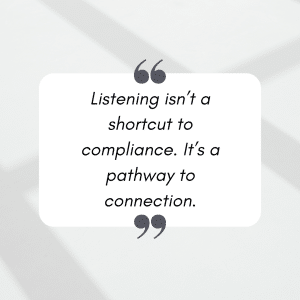A client of mine recently came to me feeling deeply frustrated.
“My employees just aren’t making the adjustments necessary for success.”
What she meant was that—due to major shifts in budgeting—her team needed to change how they did their work. Processes, priorities, even pace—everything was being restructured. But instead of adapting, her team was resisting. Hard.
Sound familiar?
Meanwhile, the pressure from her boss was mounting.
She was stuck in the middle: being asked to lead transformation… without the traction to actually make it happen.
As we talked, we uncovered something important:
The root of her team’s resistance wasn’t laziness or defiance.

That kind of fear can’t be managed away with tighter control or more meetings. It needs something else entirely.
So I asked her:
“What’s the antidote to fear?”
After some back-and-forth, she landed on a powerful truth:
Love is the antidote to fear.
And love, in leadership, often looks like listening.
She agreed to try a listening technique I gave her—something simple and rooted in presence and curiosity. No agenda. Just a real attempt to hear her team.
A few days later, I got a text:
“I tried, but it didn’t work.”
I asked her, “How do you know it didn’t work?”
Her reply?
“Lol I started strong… then I fell apart and started being bossy 😳.”
That moment right there? That’s where so many leaders stumble.
Listening Is Not a Shortcut to Compliance
When we “use” listening as a tactic to get people to change, it stops being listening—and starts being manipulation.
The truth is:
The only measure of successful listening is whether the other person feels heard.
That’s it.
Not whether they agree.
Not whether they comply.
Not whether they magically transform.
Just: Do they feel seen, heard, and understood?
When we bring expectations to listening—especially the expectation that “if I listen, they’ll change”—we’re not listening at all. We’re negotiating. We’re controlling. We’re trying to engineer an outcome.
And people can feel that.
They might nod.
They might smile.
They might even say, “Thanks for listening.”
But deep down, they don’t feel heard. They feel managed.
What Authentic Listening Looks Like
Real listening isn’t a leadership technique.
It’s not a productivity hack.
It’s not a way to “get” people to do what you need.

No outcome. No strings.
Just presence, curiosity, and care.
And ironically—it’s when people feel safe, seen, and understood that they actually become more open to change.
But that’s not the goal of listening. That’s just the natural byproduct of a healthy relationship.
Key Takeaways:
- Real listening is about them, not you.
You’re not listening to get something—you’re listening to give something.
- You only know if it “worked” if they feel heard.
That’s the metric. Not behavior. Not agreement. Just felt understanding.
- Listening to get people to change isn’t listening—it’s manipulation.
When there’s an agenda behind your attention, people can feel it.
- Start from a place of real curiosity.
If you don’t actually want to hear what they’re experiencing, no technique will work.
So if you’re a leader navigating change—especially difficult, fear-inducing change—remember this:
You can’t listen your way into control.
But you can listen your way into connection.
And from connection, trust grows.
And from trust, real change becomes possible.
But it starts with your willingness to sit in the discomfort…
To hear the fear…
To drop the agenda…
And to listen—not to fix, not to persuade, but simply to understand.
Because sometimes, the most powerful leadership move is also the simplest:
Just. Listen.



